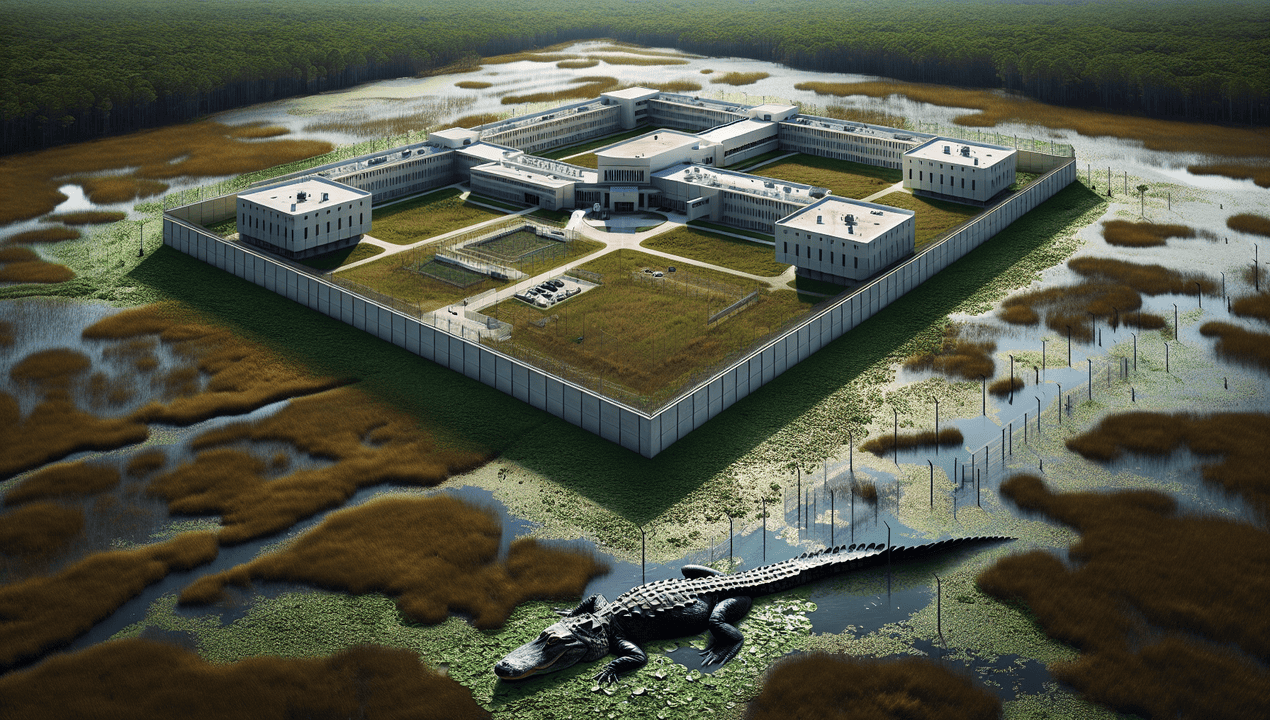
Independent Report – U.S. Homeland Security Secretary Kristi Noem recently announced that she is engaged in discussions. With five Republican-led states regarding the establishment of a new migrant detention facility. This prospective site would be modeled after the “Alligator Alcatraz” detention center located in Florida. Noem revealed these plans during a press conference held in Florida. Highlighting the interest other states have shown in replicating the unique approach of the Florida facility.
The “Alligator Alcatraz” center is known for its remote location in a vast subtropical wetland area. Approximately 37 miles from Miami. The region surrounding the facility is home to a variety of wildlife, including alligators, crocodiles, and pythons. Which contribute to the site’s isolated and secure environment. This natural barrier, combined with Homeland Security measures, makes the detention center difficult to access. And also provides an additional layer of security that sets it apart from other detention locations.
Noem explained that several states have already expressed interest in using the “Alligator Alcatraz” model as a template for collaboration with the federal government. She did not disclose the names of the states currently in talks. But emphasized the significance of this model in shaping future detention strategies. The intent is to develop facilities that effectively manage migrant populations while ensuring operational security. Through innovative approaches like those used at the Florida site.
The Secretary’s comments come at a time when the United States continues to face complex challenges related to immigration and border security. With rising numbers of migrants arriving at U.S. borders. Federal and state authorities are exploring new solutions to address overcrowding and improve detention conditions. The adoption of specialized detention sites like “Alligator Alcatraz” is seen as a potential way to balance security concerns with humanitarian considerations.
The remote and wildlife-rich environment of the Florida facility serves not only as a deterrent. But also as a natural safeguard. Its location in a wetland area means that escape attempts are complicated by the presence of dangerous animals and difficult terrain. This aspect of the facility has attracted attention from officials seeking effective ways to maintain control over detainee populations.
Also Read : Farm Worker Dies After Immigration Raid on California Farm
Although specific operational details of the “Alligator Alcatraz” facility remain limited to the public. It is understood that the site was developed with the goal of improving the management of migrants held in custody. The site combines physical isolation with federal oversight to create a detention environment that can handle large numbers of migrants securely.
Noem’s announcement about the potential expansion of this detention model reflects ongoing efforts by the Department of Homeland Security to innovate within immigration enforcement. By collaborating with Republican-led states. The federal government aims to create a network of facilities that adopt best practices for security and detention management. This approach also involves leveraging state resources and local cooperation to enhance overall border security operations.
Critics of such detention facilities often raise concerns about the conditions within migrant detention centers and the potential impact on human rights. The use of remote and heavily secured locations, while addressing security challenges. May also complicate access for legal representatives, family members, and humanitarian organizations. These issues remain a topic of debate among policymakers, advocacy groups, and the public.
The announcement highlights the evolving nature of U.S. immigration enforcement and the search for sustainable solutions amid shifting political and social landscapes. The focus on partnerships between the federal government and individual states underscores the complexity of managing migration at both national and regional levels.
Secretary Noem’s remarks also suggest that the federal government is open to innovative and perhaps unconventional methods to address the ongoing migrant detention needs. The “Alligator Alcatraz” site, with its unique environmental and security features. Provides an example of how detention strategies can adapt to the challenges posed by geography and migration patterns.
As discussions continue with the five unnamed states, further details regarding the potential new detention sites are expected to emerge. These developments will likely influence the broader national conversation about immigration policy, detention practices, and border security.
In summary, U.S. Homeland Security Secretary Kristi Noem is actively engaged in talks with several Republican-led states to replicate the Florida “Alligator Alcatraz” detention center model. This facility’s distinct combination of remote location and natural barriers has made it a noteworthy example in migrant detention strategy. The expansion of this model reflects a broader effort to enhance border security through collaboration and innovative detention solutions, amid ongoing debates about immigration enforcement in the United States.
Also Read : This Startup Creates Artificial Legs Using AI, and the Results Are Amazing!